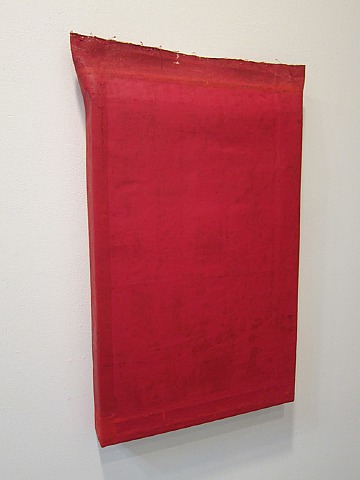
New folded-over paintings and other works.
Mid April — Late June
It was that red painting — a psychedelic fantasy that drew me to the window. It was late and (RED), 2011 was illuminated with the gentlest of light; it was like a brain freeze. Like velvety artificially bright red water ice. It was hard to pull myself away. Then Blue with it's staples puckering the surface in an almost uncomfortable way. Upon closer inspection the turned and folded corners reveal surprising details, patterns, thin paintings unto themselves nestled between the canvas edges and the wall.
These paintings by Steve Riedell seduce you. The saturated color, the yummy textures, the surprising edges tucks and folds require intimate inspection.
Larry Becker Contemporary Art
43 North Second Street
Philadelphia, Pennsylvania 19106 USA
Tel : +1-215-925-5389
from notes by Steve Riedell, Folded-Over Paintings May 11, 2011
While working in the studio on the folded-over paintings my concerns were mostly formal and much of the time I was lost in the process of making them. The reemergence of the stretched canvas and subsequently the use of the staple to fasten the canvas to its wood support is most significant. Up until this point, with a few exceptions (mostly early work), the canvas had been glued tight with matte medium to a wood panel. In these works the canvas was initially painted while stapled to my work table then glued to the support panel where the application of oil paint and beeswax would continue. With these new stretched works the journey back and forth between table top and stretcher for the canvas is recurrent until the right fit is achieved. In this I am continually making and unmaking the painting.
Shifting planes of color occur as the canvas and stretcher are refit and they blur the distinction between frontal plane, sides, top and bottom. In some instances a portion of what was previously the back of a painting becomes visible and that which was formerly apparent becomes hidden. Jasper Johns’ painting from 1964, Souvenir 2 , where one stretcher is reversed and attached face down to another painting, has been of interest to me. I've wondered, is the painting hiding or looking inward? Here, what is unintentional becomes the focus and the planned is out of sight.
The canvas puckers and dimples where staples have been removed and the painted fabric readjusted. Sometimes the staples are left in (crimped on the reverse) where they perform no function. Other times they are embedded in the wood and echo the support below. Tiny twin air holes pierce the painted skin of the works where previously they have been attached to my table top. Creases and folds are also apparent and hint at the past life of the painting.
In the exhibition two paintings hang at an angle because a portion of the upper stretcher has been removed and the canvas folded-over. I've thought of them as falling/rising, in flux. A friend commented that they looked as if they were tilting up towards the sun and the light. I like this reading.